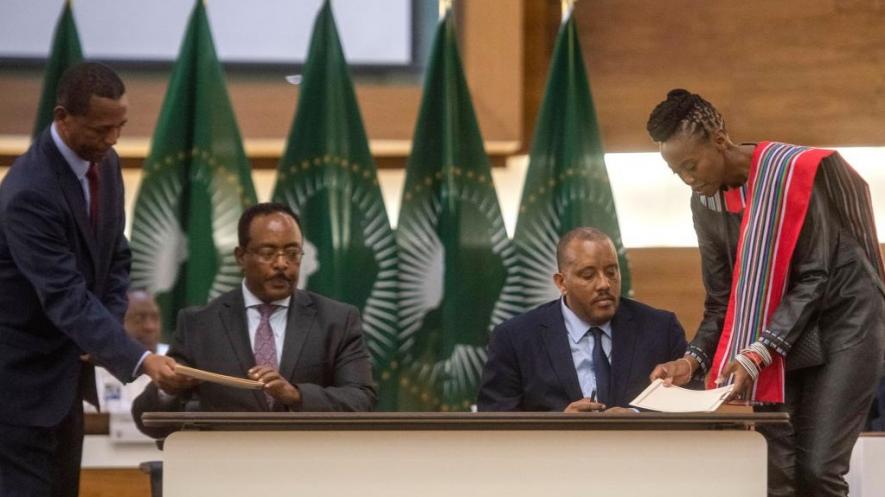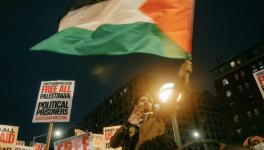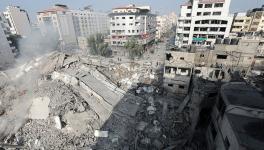Ethiopian Peace Agreement Receives Cautious Welcome Amid Concerns Over Western Pressure

Redwan Hussien Rameto (2nd L), representative of the Ethiopian government, and Getachew Reda (2nd R), representative of the Tigray People's Liberation Front (TPLF), signed a peace agreement in Pretoria, South Africa. Photo: Alet Pretorius/Xinhua
On Monday, November 7, senior leaders of the Ethiopian National Defense Forces (ENDF) and the rebel Tigray People’s Liberation Front (TPLF) met in Kenya’s capital Nairobi to “work out detailed modalities for disarmament for the TPLF combatants”, as per the peace agreement.
The peace agreement was signed between the Ethiopian federal government and the TPLF in South Africa’s executive capital Pretoria on November 2, the eve of the completion of two years of the civil war in northern Ethiopia.
The TPLF had started the war on November 3, 2020, by launching an attack on Ethiopia’s largest army base, reportedly killing thousands of soldiers and looting its armory containing 70% of ENDF’s weapons stock.
The agreement concluding this war requires the TPLF to be disarmed of all its heavy weapons, within ten days of the conclusion of the meeting that started yesterday in Nairobi, although the “ten-day period could be extended based on the recommendation of the senior commanders”.
The “overall disarmament of the TPLF combatants, including light weapons” should be completed by December 2, “within 30 days from the signing”, adds the agreement, signed after a 10-day-long negotiation, led by the African Union (AU). The UN had an observer status on the negotiating table, while the US described its status as “both.. a participant and an observer”.
Formally titled “Agreement for lasting peace through a permanent cessation of hostilities,” it was referred to as a “peace agreement” in the joint statement signed by the federal government and the TPLF. Olusegun Obasanjo, AU High Representative for Horn of Africa, who led the negotiations, also referred to “peace agreement” in his press address after the signing.
However, US State Secretary Antony Blinken did not acknowledge it as a peace agreement in his statement, which simply welcomed “the signing of a cessation of hostilities,” omitting even the word “Permanent,” which is included in the formal title of the agreement.
Challenges to disarmament
His statement, which is “undermining the peace process”, did not use “the main word, disarmament,” Ethiopian-American journalist Hermela Aregawi told BreakThrough News. “So it is like they are distancing themselves from the very thing that will create peace. It looks like they are giving room for the TPLF to continue to stay armed,” she opined.
“Credible sources indicate that 90% of the TPLF’s military capacity had been destroyed. It was forced to agree to disarmament against its will,” Elias Amare, editor of Horn of Africa TV, told Peoples Dispatch.
“Disarm TPLF!” has been a slogan of hundreds of thousands at peace demonstrations and rallies inside Ethiopia and by the diaspora in several cities of the US and Europe, condemning their support to the TPLF. A successful disarmament would be as much a victory of the Ethiopian civil society movement.
However, some observers remain skeptical about the implementation of the disarmament. Addressing the press conference after the signing of the peace agreement, TPLF’s spokesperson Getachew Reda, who led its delegation, had remarked: “I know there are spoilers from.. inside our ranks… We also know that they would not stop at nothing to sabotage our peacemaking efforts, and it is only through our collective resolve that we can hold these spoilers in check.”
Tsegaye (name changed), a prominent Ethiopian academic who has been closely following the conflict, told Peoples Dispatch, speaking on the condition of anonymity, that the “US continues arming and training thousands of TPLF fighters masquerading as refugees in eastern Sudan.” Elias, however, believes “it is too early to worry about the fighters in eastern Sudan,” and points out that all their previous armed incursions into Ethiopia over the last months of the conflict have been decisively defeated by the ENDF.
The agreement also facilitates ENDF’s entry into Mekele. It states that “the ENDF and other relevant Federal Institutions shall have an expeditious, smooth, peaceful, and coordinated entry into Mekelle, which shall be facilitated through the open communication channel,” set up between senior commanders on November 3.
While arguing for the need of utmost vigilance to ensure the implementation of this agreement, Elias maintains “it is effectively game over for the TPLF. It will no longer be capable of threatening Ethiopia’s sovereignty and territorial integrity on behalf of its puppet master, the US.”
TPLF to become a legal political party
Tsagaye, however, points out that despite TPLF’s military defeat by the ENDF on the battlefield, its ‘puppet master’, sitting on the negotiating table “both as a participant and an observer”, has in fact manage to secure its proxy’s survival, now as a legal entity.
The multiple stresses in the agreement on “political dialogue” to resolve “political differences” implies that TPLF will continue operating as a political party. Tsegaye also argues that couched in references in the agreement to “reconciliation, and healing”, the federal government has effectively promised an amnesty to TPLF leaders for all their crimes.
The federal government has committed in the agreement to “Facilitate the lifting of the terrorist designation of the TPLF by the House of Peoples’ Representatives.”
“The people of Amhara and Afar will never psychologically accept this,” Tsegaye argues. The TPLF troops have committed large-scale atrocities in these neighboring States it had invaded from Tigray after the withdrawal of ENDF following the federal government’s unilateral declaration of ceasefire mid-last year. Burning of villages, mass-killings of civilians, gang-rapes, looting of food-warehouses and destruction of thousands of medical facilities are among its documented atrocities.
With the help of regional militias of Amhara and Afar, the ENDF pushed the TPLF – which had reached as close as 200 kilometers to Ethiopia’s capital Addis Ababa – all the way back into Tigray by the start of 2022. Under pressure from the US and UN – which had been portraying it as the aggressor throughout the conflict – the federal government announced another ceasefire in March.
The TPLF reciprocated, and the ceasefire held out until August 24, when, only weeks after a delegation by the US and the EU met the TPLF leaders in Mekele, the TPLF resumed war and invaded Amhara again. Its southward attack from Tigray targeted Raya, and on the western front, it attacked the region of Tsegede, Wolkait and Humera.
The TPLF – which had annexed these Amhara lands into Tigray State when it seized federal power over all of Ethiopia in 1991 – calls these regions as Southern Tigray and Western Tigray respectively. During its 27-year-reign over Ethiopia from 1991, the TPLF is alleged to have committed large-scale and systematic ethnic cleansing, especially in the region it calls Western Tigray, to rid the Amhara population from this strategic region on the border with Sudan.
The annexed regions were wrested from the TPLF after fighting during the initial months of the war, and brought back under the control of Amhara regional State. Since then, Amhara militias have repeatedly fought and defended the areas from multiple TPLF offensives.
Arguing that the Amhara people are “a primary stakeholder” in this conflict, the Amhara Association of America (AAA) had demanded that “Amhara People’s Negotiations Delegation” be represented in the negotiations.
It consisted of four main negotiators, backed by a “delegation of more than 40 Amhara leaders from different segments of Amhara society.” AAA had argued its inclusion “would promote justice and accountability for war crimes and ensure any negotiated settlement receives wide reception and acceptance among Amharas, the largest stakeholder in the war.”
“Concessions to TPLF can provoke conflict with Amhara”
The bitterness provoked by the perceived amnesty, ceded to TPLF leaders in the negotiation from which the Amhara delegation was excluded, has only been exacerbated by what appears to be a thinly-veiled reference in the agreement to Wolkait and Raya.
The agreement states that the Federal Government and the TPLF “commit to resolving issues of contested areas in accordance with the Constitution of the Federal Democratic Republic of Ethiopia.”
This constitution, Tsegaye points out, was put into effect by the TPLF in the 90s after it had annexed these regions. The reference to the constitution in the above statement of the agreement, he argues, is an indication of the federal government’s intention to return these areas to Tigray.
Concerning the boundaries of the States, this constitution explicitly says little beyond, “States shall be delimited on the basis of the settlement patterns, language, identity and consent of the people concerned.”
Elias argues that the reference to the constitution was simply a way of avoiding an impasse in the negotiation, and does not necessarily imply that the regions will be handed over to Tigray. “The Wolkait and Humera region have been a part of Amhara for centuries before it was annexed by the TPLF. The ethnic cleansing it carried out for decades in order to change the demography of the region is very well documented. There are provisions within this constitution to appeal to the upper house for redressal of such grievances. But the TPLF was using its power to block any such attempts,” he explained.
Elias is confident that the federal government will use these provisions to ensure that the regions are not returned to Tigray. The contested Wolkait and Humera regions in the west have an additional strategic significance in that if returned to Tigray, it would give the TPLF a corridor to Sudan, whose military junta is known to be supporting the group.
The lack of clarification from the federal government about these contested areas has already provoked tensions in Amhara. “This constitution does not define the boundaries of Ethiopia,” said AAA’s chairperson, Tewodrose Tirfe. However, “we know what they are trying to say” in this reference to the constitution, he said, adding “the situation right now on the ground” is that “Wolkait is being administered by Gondor (district of Amhara), Raya is being administered by Wollo.”
“We have lost too many innocent lives and too many patriots to lose Raya and Wolkait again. That is a red line for Amharas, and any attempt to change that is going to result in additional conflict.”
The Amhara militias have played a critical role, fighting alongside the ENDF, which, after defeating TPLF’s latest offensive, marched into Tigray, wresting control of several strategic towns and cities around Mekele.
Does the TPLF have a political future?
The TPLF was in no position to defend its stronghold by the time the negotiations had begun in Pretoria. Nevertheless, argues Tsegaye, the “US won back on the negotiating table what it had lost to the Ethiopian government on the battlefield, namely the political survival of its main proxy in the region.”
Elias is not convinced that the agreement can ensure TPLF’s political survival. “600,000 Tigrayans who were forcibly conscripted by the TPLF and used as cannon fodder in human wave attacks in this war are said to have lost their lives. This is enormous for a population of less than 6 million,” he pointed out.
“The TPLF leaders will be questioned back in Tigray, ‘Where are our children? What did they die for?’ The TPLF has no answer. If a free and fair election is held as promised in the agreement, we may well be looking at the end of TPLF’s political future.”
Elias admits however that whether or not opposition parties are well-organized and strong enough to contest in any such upcoming election and defeat the TPLF remains unknown. Most of them are relatively new, formed only after 2018, when pro-democracy mass demonstrations put an end to TPLF’s 27 years of US-backed authoritarian rule over Ethiopia, during which opposition parties and free press were banned.
Even after TPLF’s ouster from the federal government, it remained a regional force, in power in Ethiopia’s northernmost State of Tigray. “For more than 30 years since 1991, the TPLF has not allowed free political activity in Tigray. It had total domination over the state’s finances and security, and cracked down brutally on any opposition groups challenging it in Tigray. This will be the first time an opportunity will be created for opposition parties to contest the TPLF in a free and fair election,” Elias argues.
However, until such an election can be “held under the supervision of the Ethiopian National Election Board”, the agreement states that Tigray will be governed by “an inclusive Interim Regional Administration” – inclusive of the TPLF, that is. It remains to be seen whether under the rule of such an administration, opposition parties will be able to freely organize and campaign against the TPLF.
TPLF’s victory in the election in Tigray would also win it a share of power in the federal government against which it had taken arms. “The Federal Government shall ensure and facilitate the representation of the Tigray region in the federal institutions, including the House of Federation, and House of Peoples’ Representatives,” the agreement states.
Nevertheless, Ethiopian civil society and diaspora organizations have exuded confidence of being able to tackle the TPLF on the political field, and have largely welcomed the agreement which ends the military conflict.
The TPLF has agreed “that the Federal Democratic Republic of Ethiopia has only one defense force”, which is the ENDF. It has committed to “[r]efrain from aiding and abetting, supporting, or collaborating with any armed or subversive group in any part of the country” and “from conscription, training, deployment, mobilization, or preparation for conflict and hostilities”. It has also committed to “[h]alt any conduct that undermines the sovereignty and territorial integrity of Ethiopia, including unconstitutional correspondence and relations with foreign powers”.
Elias argues it is of relevance that nowhere in the agreement, or in any of the addresses by African leaders to the press conference in Pretoria following the signing of this peace deal, was the TPLF referred to as the Tigray Defense Forces (TDF) or Tigrayan authorities. The latter terms, used by the US and the UN, rendering the TPLF an air of legitimate authority, have been refuted by the AU, Elias observed.
“AU has refused to scapegoat Eritrea”
He also finds the absence of any reference to Eritrea in the agreement or in the press addresses after the signing to be noteworthy. The TPLF had initially set the withdrawal of Eritrean troops – who are alleged to be in Tigray to assist the ENDF’s campaign against the TPLF – as a non-negotiable requisite for peace. The US, EU and the UN, had all amplified the TPLF’s demand for withdrawal of Eritrean troops.
For Eritrea, nothing less than its peaceful relations with Ethiopia will be at stake if the TPLF is successfully resurrected by the West. It was the TPLF which, while ruling Ethiopia with the support of the US, had led the country into a war against Eritrea. Following its ouster from federal power in 2018, Abiy Ahmed, who subsequently took charge as the prime minister, signed a peace deal with Eritrea which won him the Nobel Peace prize. The TPLF opposed the deal.
“Remember, after starting this war against the Ethiopian government, it was the TPLF which fired rockets into Eritrea, dragging it into this conflict. The AU knows this,” Elias said. By its omission of any mention of Eritrea in the agreement or in the subsequent press conference, the AU, he argued, has refused to play along with the western attempts “to scapegoat Eritrea and deflect attention from the aggressor, which is the TPLF.”
Elias maintains that the successful conclusion of a peace agreement in Pretoria is a victory not only for the people of Ethiopia and its neighbors with a common stake in peace in the Horn of Africa, but also for the AU. Despite all the efforts by the US and EU to skew the negotiation in favor of the TPLF – and what was perceived by many Ethiopians as an impartial conduct of the UN weighed down by western pressure – the AU, he argues, upheld respect for Ethiopia’s sovereignty.
The peace agreement, he said, is a realization of its slogan “African solutions for African problems”. In its realization, Elias reads the declining US hegemony and sees the first rays of a dawning multipolar world.
Tsegaye arrives at a different conclusion from the contents of the agreement. The “ruling elite” in Africa – in the Ethiopian government or at the AU – remain “neo-colonial, in character”. Their interests, he argues, are “heavily dependent on Western finance capital”. Therefore, it is only so far they can walk their anti-imperialist talk before striking a compromise and “agreeing to let the US to retain its main main proxy in the region, now operating as a legal political entity in partnership with the government.”
Get the latest reports & analysis with people's perspective on Protests, movements & deep analytical videos, discussions of the current affairs in your Telegram app. Subscribe to NewsClick's Telegram channel & get Real-Time updates on stories, as they get published on our website.
























